3803NRS - Failure to Rescue: Inter-professional Practice & Strategies
VerifiedAdded on 2023/06/09
|11
|3148
|221
Essay
AI Summary
This essay provides a comprehensive analysis of 'Failure to Rescue' in the healthcare environment, beginning with a clear definition and exploring its incidence, consequences for patients, families, and the healthcare system. It identifies key barriers to preventing failure to rescue, such as failure to respond and failure to communicate effectively. The essay further discusses strategies to overcome these barriers, emphasizing the importance of proper training for nurses and effective inter-professional communication. Nursing strategies, including improving the quality of response to adverse effects and reviewing existing protocols, are examined in detail, with a focus on inter-professional practice and patient safety. The essay concludes by underscoring the need for continuous quality improvement and the implementation of evidence-based practices to mitigate the risk of failure to rescue and improve patient outcomes.
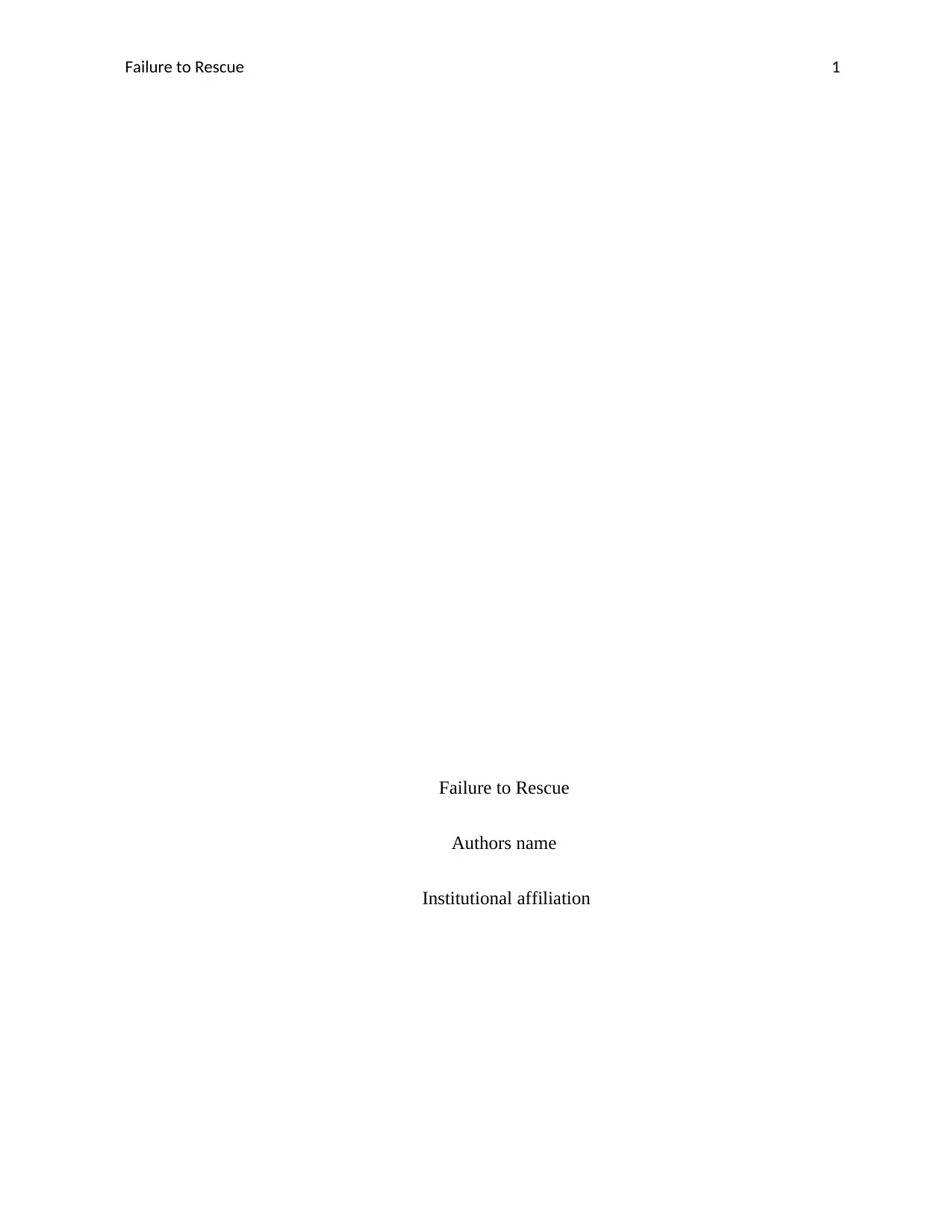
Failure to Rescue 1
Failure to Rescue
Authors name
Institutional affiliation
Failure to Rescue
Authors name
Institutional affiliation
Paraphrase This Document
Need a fresh take? Get an instant paraphrase of this document with our AI Paraphraser
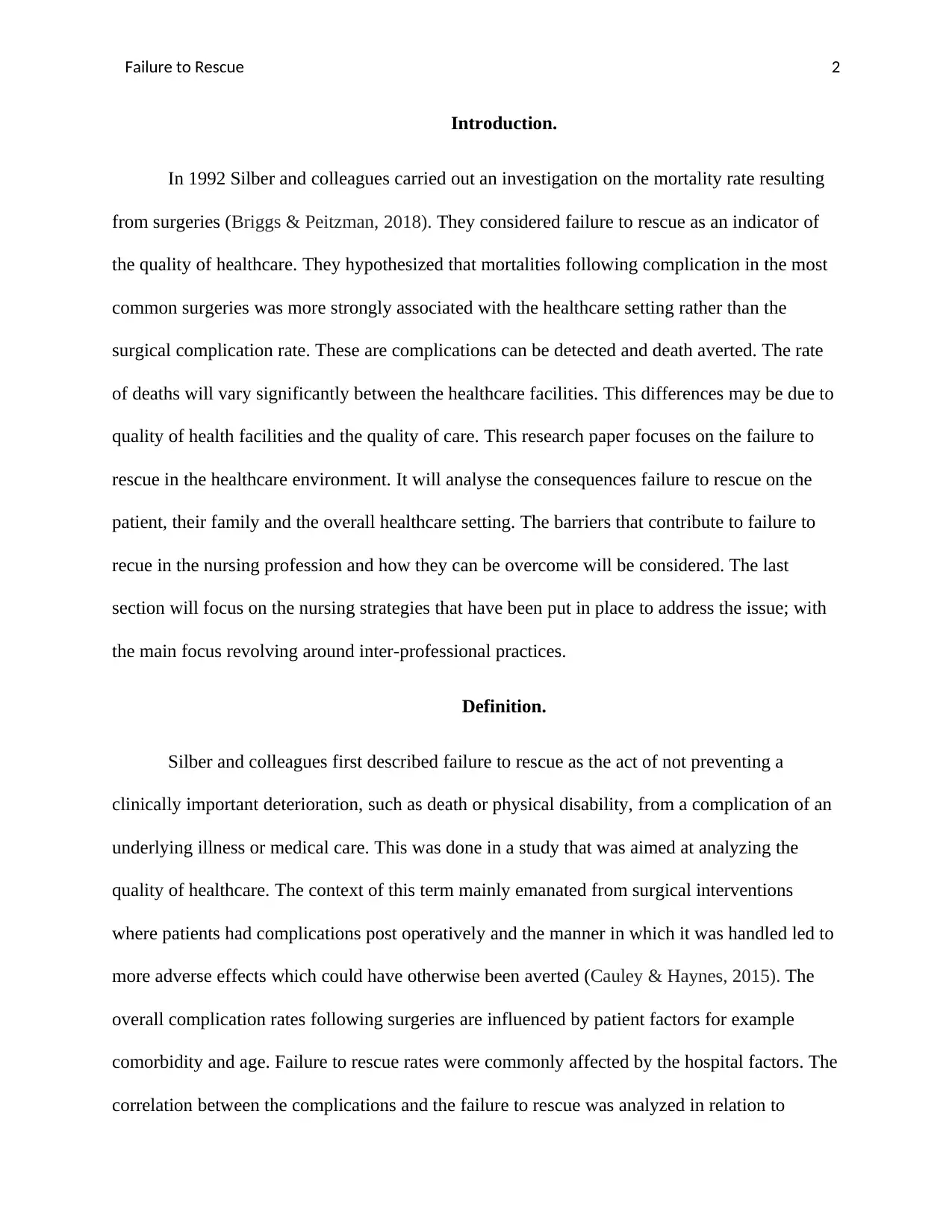
Failure to Rescue 2
Introduction.
In 1992 Silber and colleagues carried out an investigation on the mortality rate resulting
from surgeries (Briggs & Peitzman, 2018). They considered failure to rescue as an indicator of
the quality of healthcare. They hypothesized that mortalities following complication in the most
common surgeries was more strongly associated with the healthcare setting rather than the
surgical complication rate. These are complications can be detected and death averted. The rate
of deaths will vary significantly between the healthcare facilities. This differences may be due to
quality of health facilities and the quality of care. This research paper focuses on the failure to
rescue in the healthcare environment. It will analyse the consequences failure to rescue on the
patient, their family and the overall healthcare setting. The barriers that contribute to failure to
recue in the nursing profession and how they can be overcome will be considered. The last
section will focus on the nursing strategies that have been put in place to address the issue; with
the main focus revolving around inter-professional practices.
Definition.
Silber and colleagues first described failure to rescue as the act of not preventing a
clinically important deterioration, such as death or physical disability, from a complication of an
underlying illness or medical care. This was done in a study that was aimed at analyzing the
quality of healthcare. The context of this term mainly emanated from surgical interventions
where patients had complications post operatively and the manner in which it was handled led to
more adverse effects which could have otherwise been averted (Cauley & Haynes, 2015). The
overall complication rates following surgeries are influenced by patient factors for example
comorbidity and age. Failure to rescue rates were commonly affected by the hospital factors. The
correlation between the complications and the failure to rescue was analyzed in relation to
Introduction.
In 1992 Silber and colleagues carried out an investigation on the mortality rate resulting
from surgeries (Briggs & Peitzman, 2018). They considered failure to rescue as an indicator of
the quality of healthcare. They hypothesized that mortalities following complication in the most
common surgeries was more strongly associated with the healthcare setting rather than the
surgical complication rate. These are complications can be detected and death averted. The rate
of deaths will vary significantly between the healthcare facilities. This differences may be due to
quality of health facilities and the quality of care. This research paper focuses on the failure to
rescue in the healthcare environment. It will analyse the consequences failure to rescue on the
patient, their family and the overall healthcare setting. The barriers that contribute to failure to
recue in the nursing profession and how they can be overcome will be considered. The last
section will focus on the nursing strategies that have been put in place to address the issue; with
the main focus revolving around inter-professional practices.
Definition.
Silber and colleagues first described failure to rescue as the act of not preventing a
clinically important deterioration, such as death or physical disability, from a complication of an
underlying illness or medical care. This was done in a study that was aimed at analyzing the
quality of healthcare. The context of this term mainly emanated from surgical interventions
where patients had complications post operatively and the manner in which it was handled led to
more adverse effects which could have otherwise been averted (Cauley & Haynes, 2015). The
overall complication rates following surgeries are influenced by patient factors for example
comorbidity and age. Failure to rescue rates were commonly affected by the hospital factors. The
correlation between the complications and the failure to rescue was analyzed in relation to
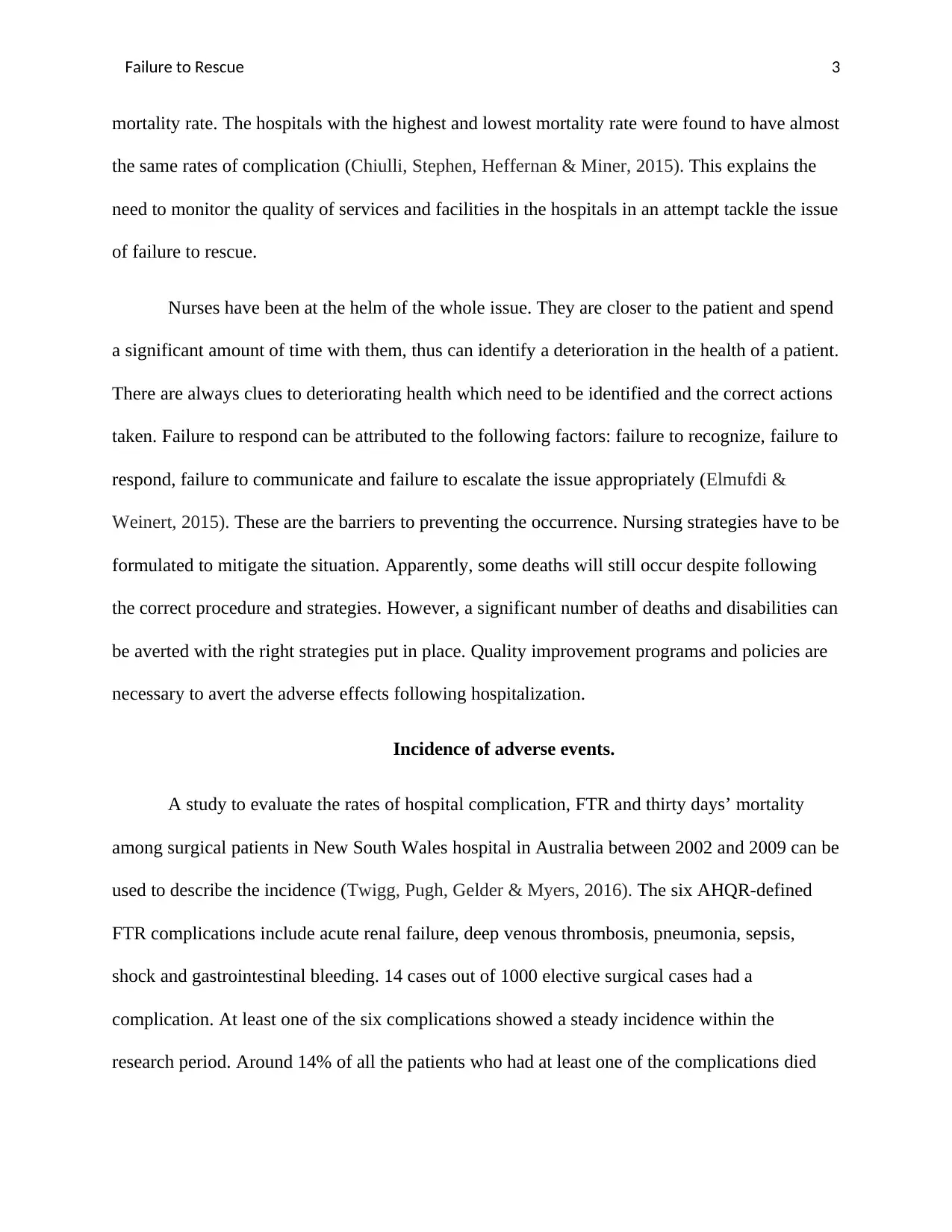
Failure to Rescue 3
mortality rate. The hospitals with the highest and lowest mortality rate were found to have almost
the same rates of complication (Chiulli, Stephen, Heffernan & Miner, 2015). This explains the
need to monitor the quality of services and facilities in the hospitals in an attempt tackle the issue
of failure to rescue.
Nurses have been at the helm of the whole issue. They are closer to the patient and spend
a significant amount of time with them, thus can identify a deterioration in the health of a patient.
There are always clues to deteriorating health which need to be identified and the correct actions
taken. Failure to respond can be attributed to the following factors: failure to recognize, failure to
respond, failure to communicate and failure to escalate the issue appropriately (Elmufdi &
Weinert, 2015). These are the barriers to preventing the occurrence. Nursing strategies have to be
formulated to mitigate the situation. Apparently, some deaths will still occur despite following
the correct procedure and strategies. However, a significant number of deaths and disabilities can
be averted with the right strategies put in place. Quality improvement programs and policies are
necessary to avert the adverse effects following hospitalization.
Incidence of adverse events.
A study to evaluate the rates of hospital complication, FTR and thirty days’ mortality
among surgical patients in New South Wales hospital in Australia between 2002 and 2009 can be
used to describe the incidence (Twigg, Pugh, Gelder & Myers, 2016). The six AHQR-defined
FTR complications include acute renal failure, deep venous thrombosis, pneumonia, sepsis,
shock and gastrointestinal bleeding. 14 cases out of 1000 elective surgical cases had a
complication. At least one of the six complications showed a steady incidence within the
research period. Around 14% of all the patients who had at least one of the complications died
mortality rate. The hospitals with the highest and lowest mortality rate were found to have almost
the same rates of complication (Chiulli, Stephen, Heffernan & Miner, 2015). This explains the
need to monitor the quality of services and facilities in the hospitals in an attempt tackle the issue
of failure to rescue.
Nurses have been at the helm of the whole issue. They are closer to the patient and spend
a significant amount of time with them, thus can identify a deterioration in the health of a patient.
There are always clues to deteriorating health which need to be identified and the correct actions
taken. Failure to respond can be attributed to the following factors: failure to recognize, failure to
respond, failure to communicate and failure to escalate the issue appropriately (Elmufdi &
Weinert, 2015). These are the barriers to preventing the occurrence. Nursing strategies have to be
formulated to mitigate the situation. Apparently, some deaths will still occur despite following
the correct procedure and strategies. However, a significant number of deaths and disabilities can
be averted with the right strategies put in place. Quality improvement programs and policies are
necessary to avert the adverse effects following hospitalization.
Incidence of adverse events.
A study to evaluate the rates of hospital complication, FTR and thirty days’ mortality
among surgical patients in New South Wales hospital in Australia between 2002 and 2009 can be
used to describe the incidence (Twigg, Pugh, Gelder & Myers, 2016). The six AHQR-defined
FTR complications include acute renal failure, deep venous thrombosis, pneumonia, sepsis,
shock and gastrointestinal bleeding. 14 cases out of 1000 elective surgical cases had a
complication. At least one of the six complications showed a steady incidence within the
research period. Around 14% of all the patients who had at least one of the complications died
⊘ This is a preview!⊘
Do you want full access?
Subscribe today to unlock all pages.

Trusted by 1+ million students worldwide
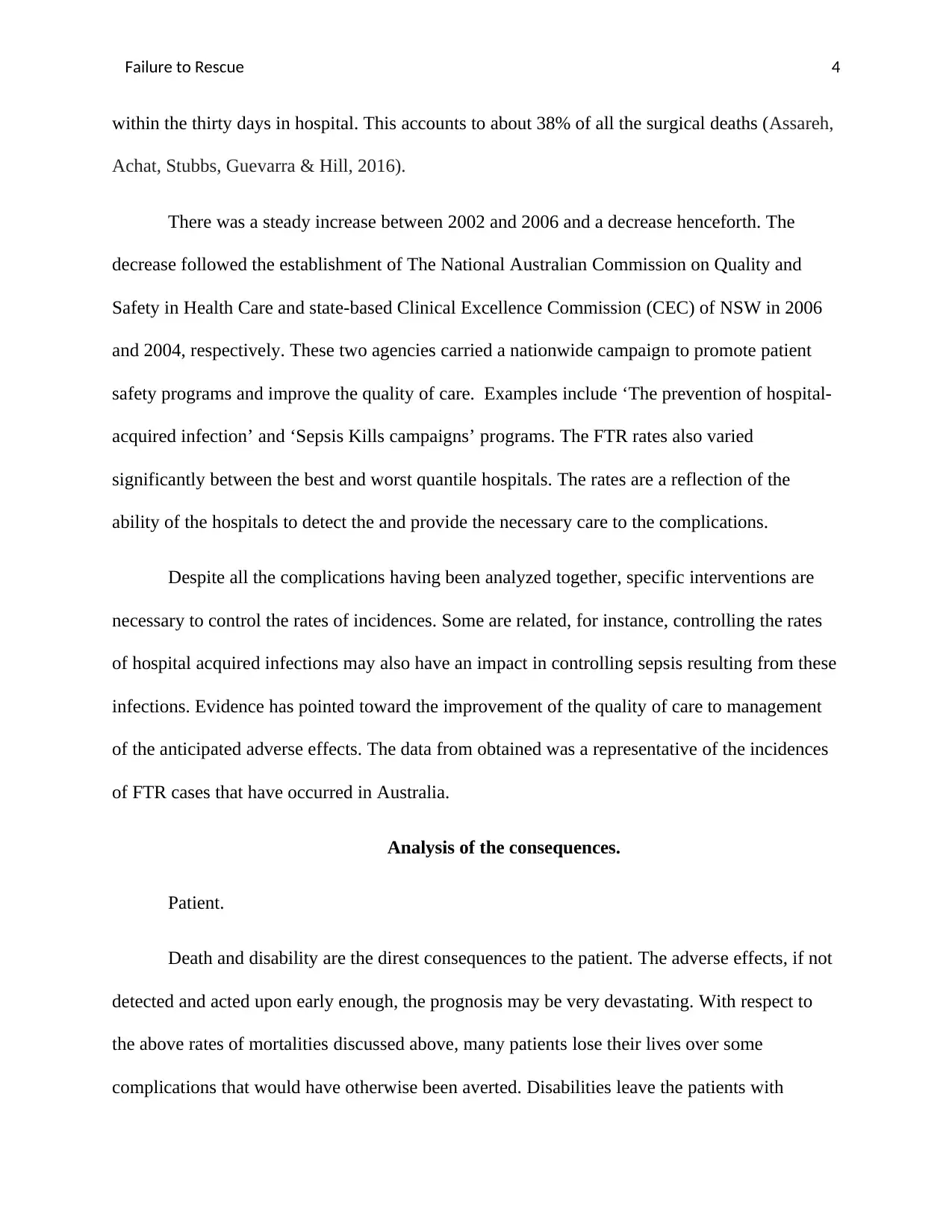
Failure to Rescue 4
within the thirty days in hospital. This accounts to about 38% of all the surgical deaths (Assareh,
Achat, Stubbs, Guevarra & Hill, 2016).
There was a steady increase between 2002 and 2006 and a decrease henceforth. The
decrease followed the establishment of The National Australian Commission on Quality and
Safety in Health Care and state-based Clinical Excellence Commission (CEC) of NSW in 2006
and 2004, respectively. These two agencies carried a nationwide campaign to promote patient
safety programs and improve the quality of care. Examples include ‘The prevention of hospital-
acquired infection’ and ‘Sepsis Kills campaigns’ programs. The FTR rates also varied
significantly between the best and worst quantile hospitals. The rates are a reflection of the
ability of the hospitals to detect the and provide the necessary care to the complications.
Despite all the complications having been analyzed together, specific interventions are
necessary to control the rates of incidences. Some are related, for instance, controlling the rates
of hospital acquired infections may also have an impact in controlling sepsis resulting from these
infections. Evidence has pointed toward the improvement of the quality of care to management
of the anticipated adverse effects. The data from obtained was a representative of the incidences
of FTR cases that have occurred in Australia.
Analysis of the consequences.
Patient.
Death and disability are the direst consequences to the patient. The adverse effects, if not
detected and acted upon early enough, the prognosis may be very devastating. With respect to
the above rates of mortalities discussed above, many patients lose their lives over some
complications that would have otherwise been averted. Disabilities leave the patients with
within the thirty days in hospital. This accounts to about 38% of all the surgical deaths (Assareh,
Achat, Stubbs, Guevarra & Hill, 2016).
There was a steady increase between 2002 and 2006 and a decrease henceforth. The
decrease followed the establishment of The National Australian Commission on Quality and
Safety in Health Care and state-based Clinical Excellence Commission (CEC) of NSW in 2006
and 2004, respectively. These two agencies carried a nationwide campaign to promote patient
safety programs and improve the quality of care. Examples include ‘The prevention of hospital-
acquired infection’ and ‘Sepsis Kills campaigns’ programs. The FTR rates also varied
significantly between the best and worst quantile hospitals. The rates are a reflection of the
ability of the hospitals to detect the and provide the necessary care to the complications.
Despite all the complications having been analyzed together, specific interventions are
necessary to control the rates of incidences. Some are related, for instance, controlling the rates
of hospital acquired infections may also have an impact in controlling sepsis resulting from these
infections. Evidence has pointed toward the improvement of the quality of care to management
of the anticipated adverse effects. The data from obtained was a representative of the incidences
of FTR cases that have occurred in Australia.
Analysis of the consequences.
Patient.
Death and disability are the direst consequences to the patient. The adverse effects, if not
detected and acted upon early enough, the prognosis may be very devastating. With respect to
the above rates of mortalities discussed above, many patients lose their lives over some
complications that would have otherwise been averted. Disabilities leave the patients with
Paraphrase This Document
Need a fresh take? Get an instant paraphrase of this document with our AI Paraphraser
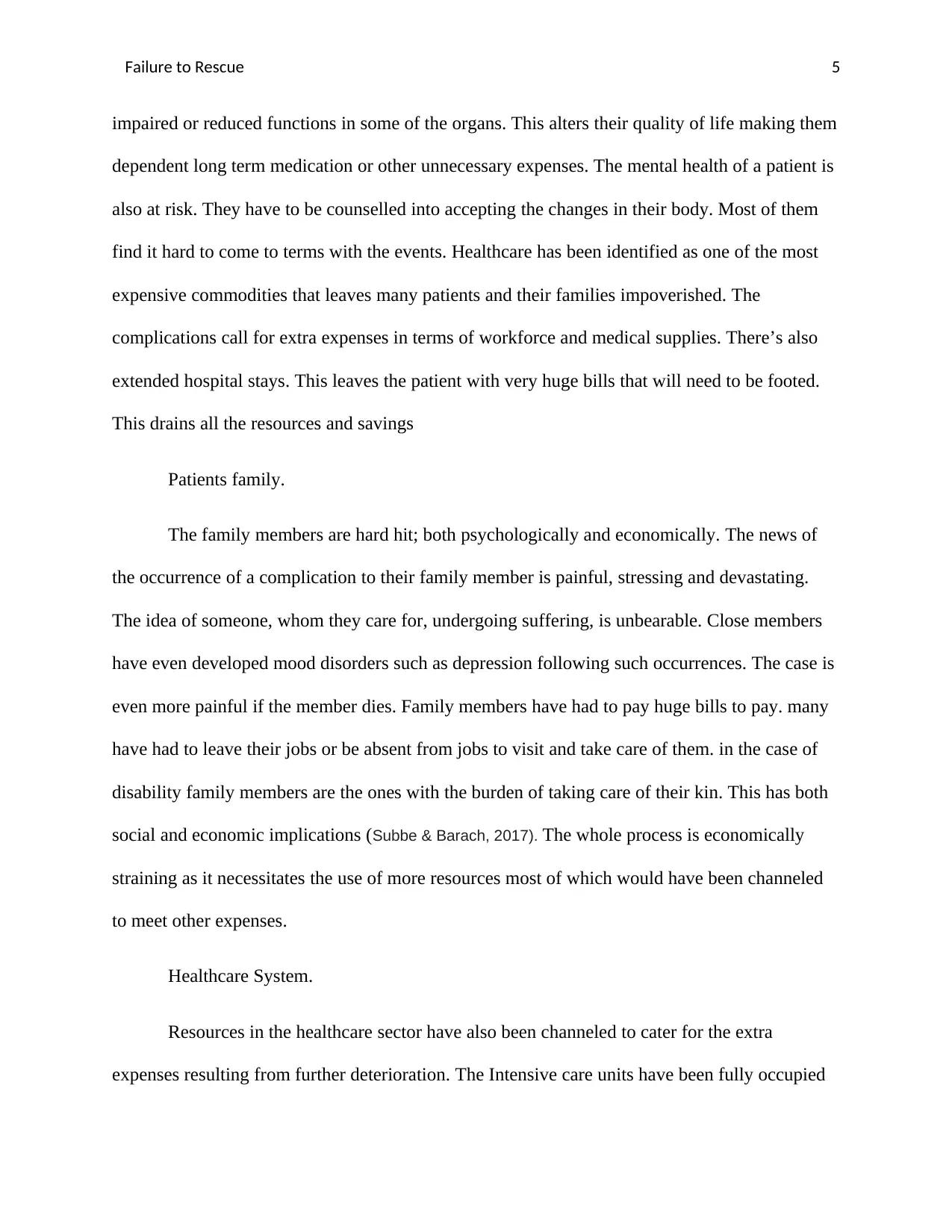
Failure to Rescue 5
impaired or reduced functions in some of the organs. This alters their quality of life making them
dependent long term medication or other unnecessary expenses. The mental health of a patient is
also at risk. They have to be counselled into accepting the changes in their body. Most of them
find it hard to come to terms with the events. Healthcare has been identified as one of the most
expensive commodities that leaves many patients and their families impoverished. The
complications call for extra expenses in terms of workforce and medical supplies. There’s also
extended hospital stays. This leaves the patient with very huge bills that will need to be footed.
This drains all the resources and savings
Patients family.
The family members are hard hit; both psychologically and economically. The news of
the occurrence of a complication to their family member is painful, stressing and devastating.
The idea of someone, whom they care for, undergoing suffering, is unbearable. Close members
have even developed mood disorders such as depression following such occurrences. The case is
even more painful if the member dies. Family members have had to pay huge bills to pay. many
have had to leave their jobs or be absent from jobs to visit and take care of them. in the case of
disability family members are the ones with the burden of taking care of their kin. This has both
social and economic implications (Subbe & Barach, 2017). The whole process is economically
straining as it necessitates the use of more resources most of which would have been channeled
to meet other expenses.
Healthcare System.
Resources in the healthcare sector have also been channeled to cater for the extra
expenses resulting from further deterioration. The Intensive care units have been fully occupied
impaired or reduced functions in some of the organs. This alters their quality of life making them
dependent long term medication or other unnecessary expenses. The mental health of a patient is
also at risk. They have to be counselled into accepting the changes in their body. Most of them
find it hard to come to terms with the events. Healthcare has been identified as one of the most
expensive commodities that leaves many patients and their families impoverished. The
complications call for extra expenses in terms of workforce and medical supplies. There’s also
extended hospital stays. This leaves the patient with very huge bills that will need to be footed.
This drains all the resources and savings
Patients family.
The family members are hard hit; both psychologically and economically. The news of
the occurrence of a complication to their family member is painful, stressing and devastating.
The idea of someone, whom they care for, undergoing suffering, is unbearable. Close members
have even developed mood disorders such as depression following such occurrences. The case is
even more painful if the member dies. Family members have had to pay huge bills to pay. many
have had to leave their jobs or be absent from jobs to visit and take care of them. in the case of
disability family members are the ones with the burden of taking care of their kin. This has both
social and economic implications (Subbe & Barach, 2017). The whole process is economically
straining as it necessitates the use of more resources most of which would have been channeled
to meet other expenses.
Healthcare System.
Resources in the healthcare sector have also been channeled to cater for the extra
expenses resulting from further deterioration. The Intensive care units have been fully occupied
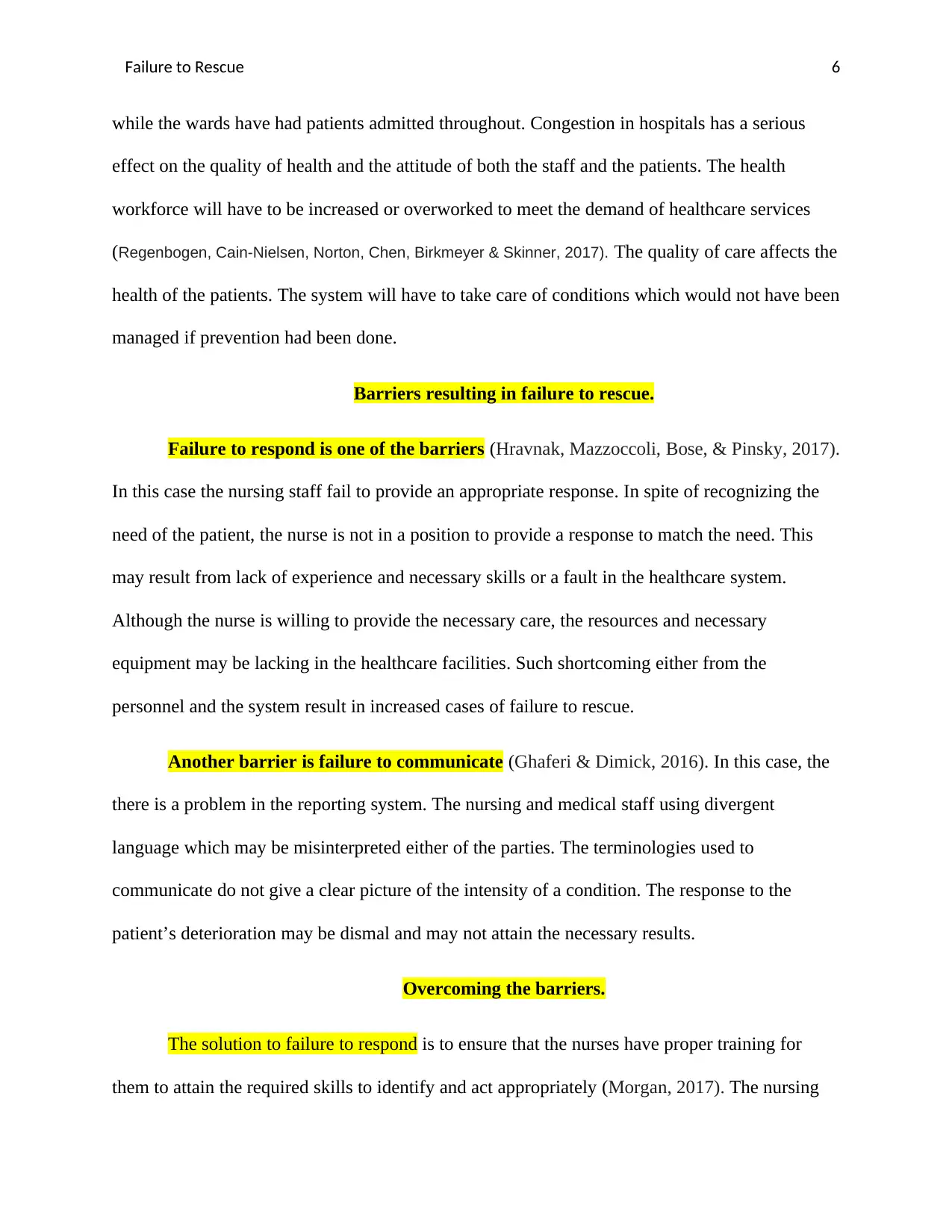
Failure to Rescue 6
while the wards have had patients admitted throughout. Congestion in hospitals has a serious
effect on the quality of health and the attitude of both the staff and the patients. The health
workforce will have to be increased or overworked to meet the demand of healthcare services
(Regenbogen, Cain-Nielsen, Norton, Chen, Birkmeyer & Skinner, 2017). The quality of care affects the
health of the patients. The system will have to take care of conditions which would not have been
managed if prevention had been done.
Barriers resulting in failure to rescue.
Failure to respond is one of the barriers (Hravnak, Mazzoccoli, Bose, & Pinsky, 2017).
In this case the nursing staff fail to provide an appropriate response. In spite of recognizing the
need of the patient, the nurse is not in a position to provide a response to match the need. This
may result from lack of experience and necessary skills or a fault in the healthcare system.
Although the nurse is willing to provide the necessary care, the resources and necessary
equipment may be lacking in the healthcare facilities. Such shortcoming either from the
personnel and the system result in increased cases of failure to rescue.
Another barrier is failure to communicate (Ghaferi & Dimick, 2016). In this case, the
there is a problem in the reporting system. The nursing and medical staff using divergent
language which may be misinterpreted either of the parties. The terminologies used to
communicate do not give a clear picture of the intensity of a condition. The response to the
patient’s deterioration may be dismal and may not attain the necessary results.
Overcoming the barriers.
The solution to failure to respond is to ensure that the nurses have proper training for
them to attain the required skills to identify and act appropriately (Morgan, 2017). The nursing
while the wards have had patients admitted throughout. Congestion in hospitals has a serious
effect on the quality of health and the attitude of both the staff and the patients. The health
workforce will have to be increased or overworked to meet the demand of healthcare services
(Regenbogen, Cain-Nielsen, Norton, Chen, Birkmeyer & Skinner, 2017). The quality of care affects the
health of the patients. The system will have to take care of conditions which would not have been
managed if prevention had been done.
Barriers resulting in failure to rescue.
Failure to respond is one of the barriers (Hravnak, Mazzoccoli, Bose, & Pinsky, 2017).
In this case the nursing staff fail to provide an appropriate response. In spite of recognizing the
need of the patient, the nurse is not in a position to provide a response to match the need. This
may result from lack of experience and necessary skills or a fault in the healthcare system.
Although the nurse is willing to provide the necessary care, the resources and necessary
equipment may be lacking in the healthcare facilities. Such shortcoming either from the
personnel and the system result in increased cases of failure to rescue.
Another barrier is failure to communicate (Ghaferi & Dimick, 2016). In this case, the
there is a problem in the reporting system. The nursing and medical staff using divergent
language which may be misinterpreted either of the parties. The terminologies used to
communicate do not give a clear picture of the intensity of a condition. The response to the
patient’s deterioration may be dismal and may not attain the necessary results.
Overcoming the barriers.
The solution to failure to respond is to ensure that the nurses have proper training for
them to attain the required skills to identify and act appropriately (Morgan, 2017). The nursing
⊘ This is a preview!⊘
Do you want full access?
Subscribe today to unlock all pages.

Trusted by 1+ million students worldwide
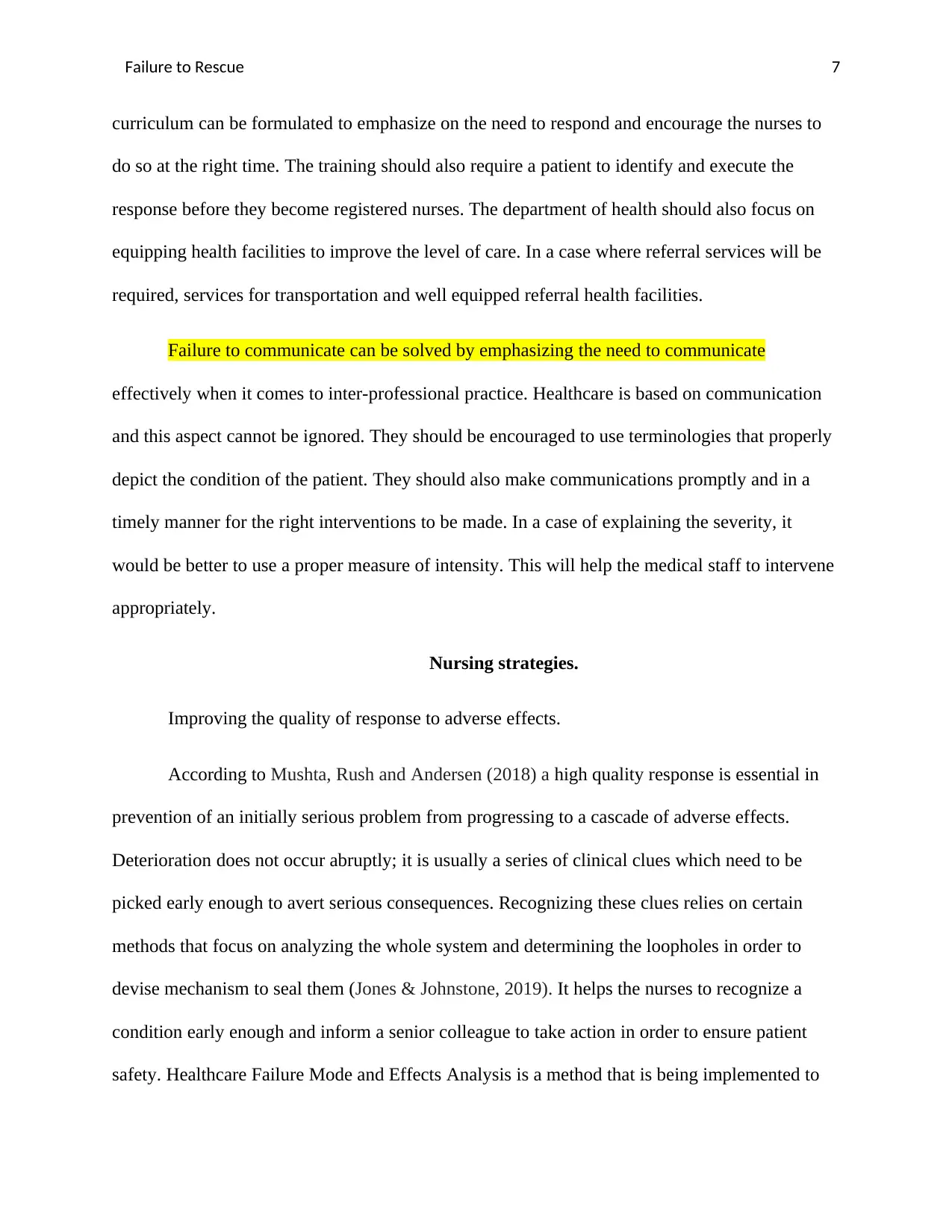
Failure to Rescue 7
curriculum can be formulated to emphasize on the need to respond and encourage the nurses to
do so at the right time. The training should also require a patient to identify and execute the
response before they become registered nurses. The department of health should also focus on
equipping health facilities to improve the level of care. In a case where referral services will be
required, services for transportation and well equipped referral health facilities.
Failure to communicate can be solved by emphasizing the need to communicate
effectively when it comes to inter-professional practice. Healthcare is based on communication
and this aspect cannot be ignored. They should be encouraged to use terminologies that properly
depict the condition of the patient. They should also make communications promptly and in a
timely manner for the right interventions to be made. In a case of explaining the severity, it
would be better to use a proper measure of intensity. This will help the medical staff to intervene
appropriately.
Nursing strategies.
Improving the quality of response to adverse effects.
According to Mushta, Rush and Andersen (2018) a high quality response is essential in
prevention of an initially serious problem from progressing to a cascade of adverse effects.
Deterioration does not occur abruptly; it is usually a series of clinical clues which need to be
picked early enough to avert serious consequences. Recognizing these clues relies on certain
methods that focus on analyzing the whole system and determining the loopholes in order to
devise mechanism to seal them (Jones & Johnstone, 2019). It helps the nurses to recognize a
condition early enough and inform a senior colleague to take action in order to ensure patient
safety. Healthcare Failure Mode and Effects Analysis is a method that is being implemented to
curriculum can be formulated to emphasize on the need to respond and encourage the nurses to
do so at the right time. The training should also require a patient to identify and execute the
response before they become registered nurses. The department of health should also focus on
equipping health facilities to improve the level of care. In a case where referral services will be
required, services for transportation and well equipped referral health facilities.
Failure to communicate can be solved by emphasizing the need to communicate
effectively when it comes to inter-professional practice. Healthcare is based on communication
and this aspect cannot be ignored. They should be encouraged to use terminologies that properly
depict the condition of the patient. They should also make communications promptly and in a
timely manner for the right interventions to be made. In a case of explaining the severity, it
would be better to use a proper measure of intensity. This will help the medical staff to intervene
appropriately.
Nursing strategies.
Improving the quality of response to adverse effects.
According to Mushta, Rush and Andersen (2018) a high quality response is essential in
prevention of an initially serious problem from progressing to a cascade of adverse effects.
Deterioration does not occur abruptly; it is usually a series of clinical clues which need to be
picked early enough to avert serious consequences. Recognizing these clues relies on certain
methods that focus on analyzing the whole system and determining the loopholes in order to
devise mechanism to seal them (Jones & Johnstone, 2019). It helps the nurses to recognize a
condition early enough and inform a senior colleague to take action in order to ensure patient
safety. Healthcare Failure Mode and Effects Analysis is a method that is being implemented to
Paraphrase This Document
Need a fresh take? Get an instant paraphrase of this document with our AI Paraphraser
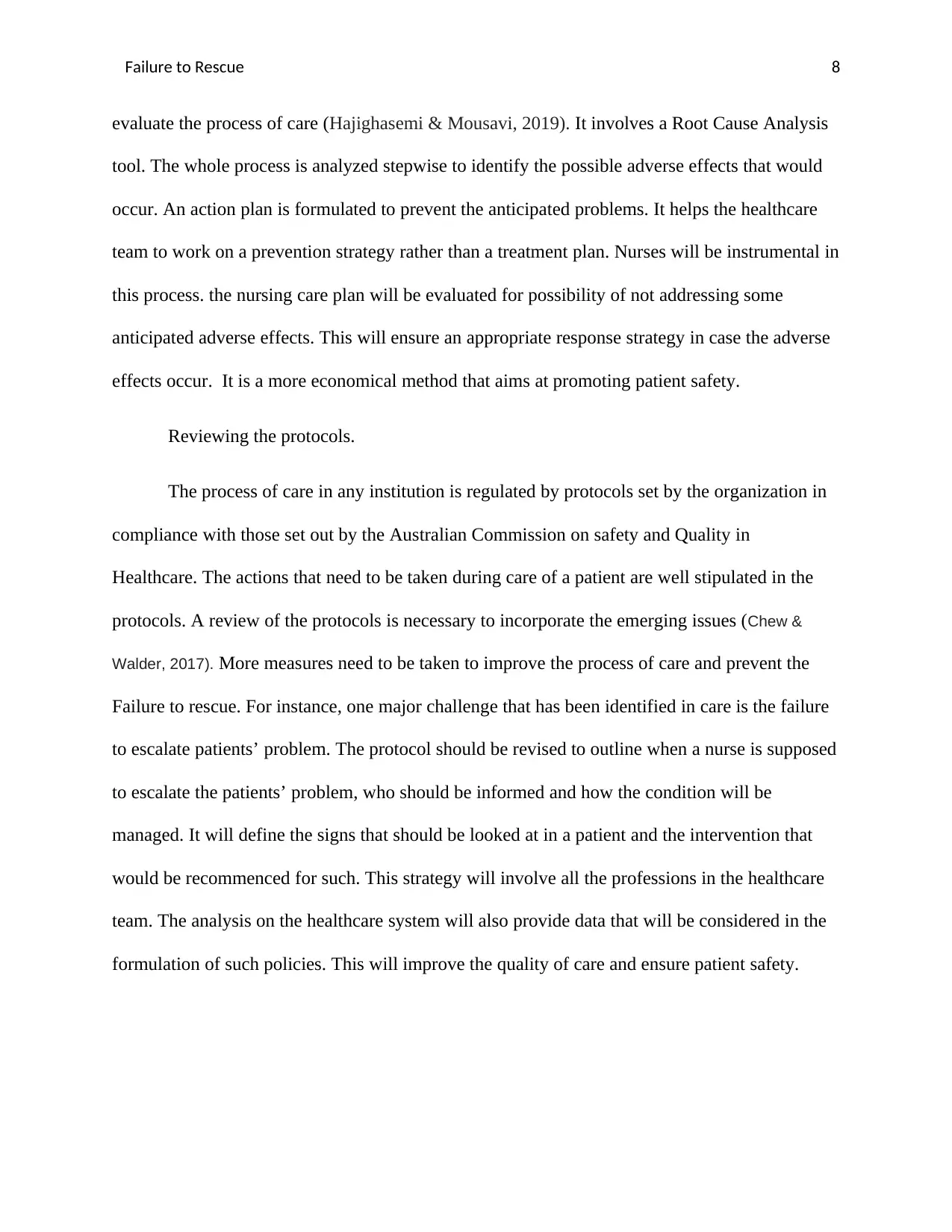
Failure to Rescue 8
evaluate the process of care (Hajighasemi & Mousavi, 2019). It involves a Root Cause Analysis
tool. The whole process is analyzed stepwise to identify the possible adverse effects that would
occur. An action plan is formulated to prevent the anticipated problems. It helps the healthcare
team to work on a prevention strategy rather than a treatment plan. Nurses will be instrumental in
this process. the nursing care plan will be evaluated for possibility of not addressing some
anticipated adverse effects. This will ensure an appropriate response strategy in case the adverse
effects occur. It is a more economical method that aims at promoting patient safety.
Reviewing the protocols.
The process of care in any institution is regulated by protocols set by the organization in
compliance with those set out by the Australian Commission on safety and Quality in
Healthcare. The actions that need to be taken during care of a patient are well stipulated in the
protocols. A review of the protocols is necessary to incorporate the emerging issues (Chew &
Walder, 2017). More measures need to be taken to improve the process of care and prevent the
Failure to rescue. For instance, one major challenge that has been identified in care is the failure
to escalate patients’ problem. The protocol should be revised to outline when a nurse is supposed
to escalate the patients’ problem, who should be informed and how the condition will be
managed. It will define the signs that should be looked at in a patient and the intervention that
would be recommenced for such. This strategy will involve all the professions in the healthcare
team. The analysis on the healthcare system will also provide data that will be considered in the
formulation of such policies. This will improve the quality of care and ensure patient safety.
evaluate the process of care (Hajighasemi & Mousavi, 2019). It involves a Root Cause Analysis
tool. The whole process is analyzed stepwise to identify the possible adverse effects that would
occur. An action plan is formulated to prevent the anticipated problems. It helps the healthcare
team to work on a prevention strategy rather than a treatment plan. Nurses will be instrumental in
this process. the nursing care plan will be evaluated for possibility of not addressing some
anticipated adverse effects. This will ensure an appropriate response strategy in case the adverse
effects occur. It is a more economical method that aims at promoting patient safety.
Reviewing the protocols.
The process of care in any institution is regulated by protocols set by the organization in
compliance with those set out by the Australian Commission on safety and Quality in
Healthcare. The actions that need to be taken during care of a patient are well stipulated in the
protocols. A review of the protocols is necessary to incorporate the emerging issues (Chew &
Walder, 2017). More measures need to be taken to improve the process of care and prevent the
Failure to rescue. For instance, one major challenge that has been identified in care is the failure
to escalate patients’ problem. The protocol should be revised to outline when a nurse is supposed
to escalate the patients’ problem, who should be informed and how the condition will be
managed. It will define the signs that should be looked at in a patient and the intervention that
would be recommenced for such. This strategy will involve all the professions in the healthcare
team. The analysis on the healthcare system will also provide data that will be considered in the
formulation of such policies. This will improve the quality of care and ensure patient safety.
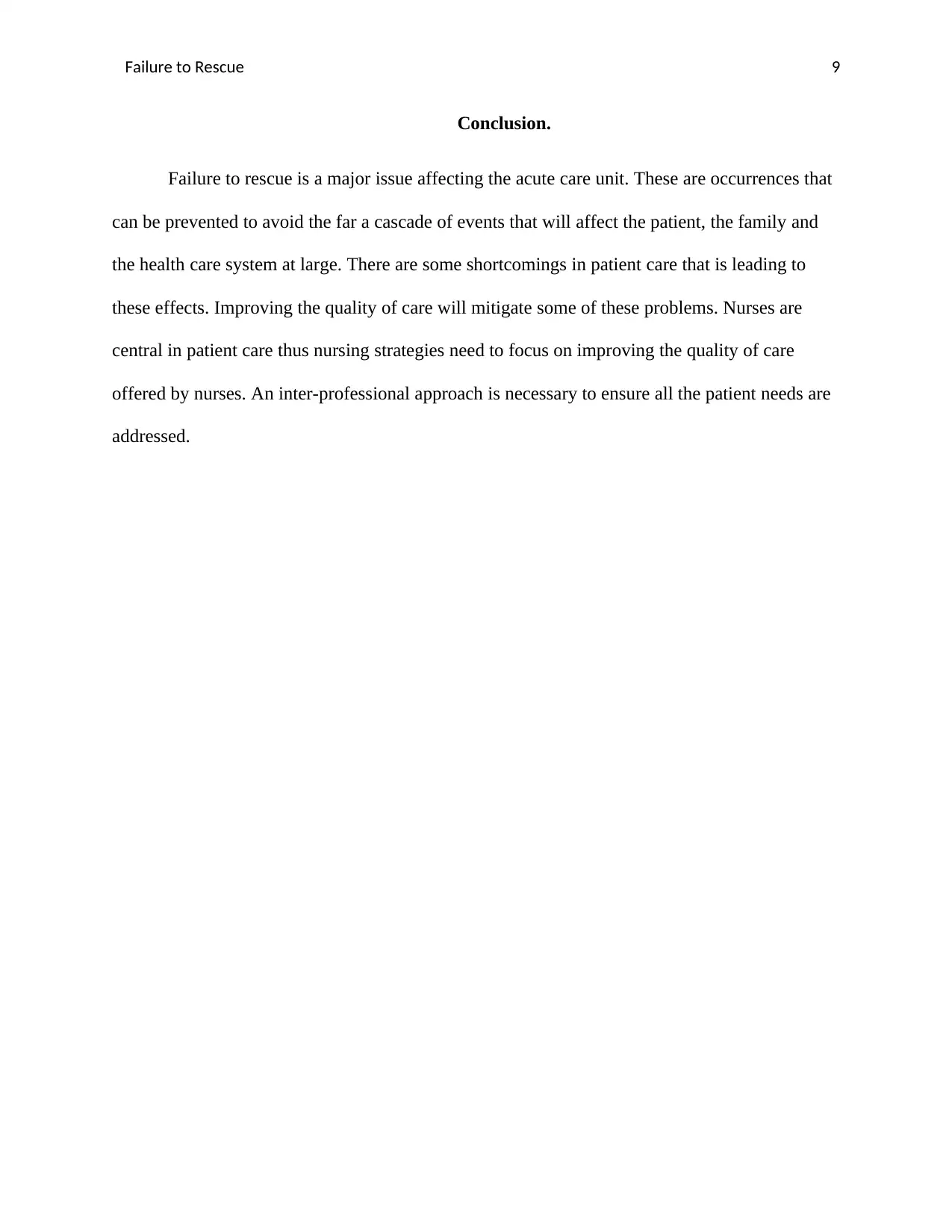
Failure to Rescue 9
Conclusion.
Failure to rescue is a major issue affecting the acute care unit. These are occurrences that
can be prevented to avoid the far a cascade of events that will affect the patient, the family and
the health care system at large. There are some shortcomings in patient care that is leading to
these effects. Improving the quality of care will mitigate some of these problems. Nurses are
central in patient care thus nursing strategies need to focus on improving the quality of care
offered by nurses. An inter-professional approach is necessary to ensure all the patient needs are
addressed.
Conclusion.
Failure to rescue is a major issue affecting the acute care unit. These are occurrences that
can be prevented to avoid the far a cascade of events that will affect the patient, the family and
the health care system at large. There are some shortcomings in patient care that is leading to
these effects. Improving the quality of care will mitigate some of these problems. Nurses are
central in patient care thus nursing strategies need to focus on improving the quality of care
offered by nurses. An inter-professional approach is necessary to ensure all the patient needs are
addressed.
⊘ This is a preview!⊘
Do you want full access?
Subscribe today to unlock all pages.

Trusted by 1+ million students worldwide
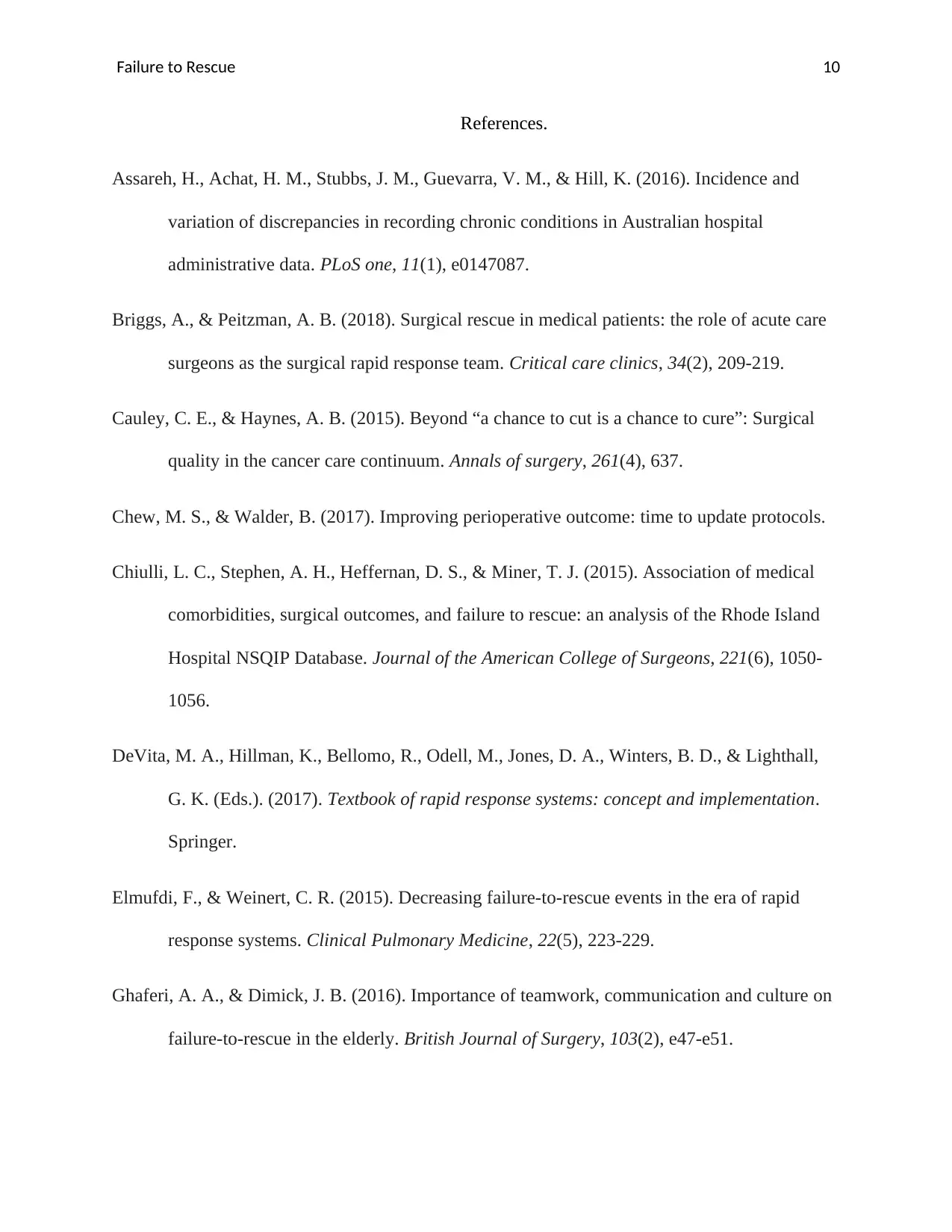
Failure to Rescue 10
References.
Assareh, H., Achat, H. M., Stubbs, J. M., Guevarra, V. M., & Hill, K. (2016). Incidence and
variation of discrepancies in recording chronic conditions in Australian hospital
administrative data. PLoS one, 11(1), e0147087.
Briggs, A., & Peitzman, A. B. (2018). Surgical rescue in medical patients: the role of acute care
surgeons as the surgical rapid response team. Critical care clinics, 34(2), 209-219.
Cauley, C. E., & Haynes, A. B. (2015). Beyond “a chance to cut is a chance to cure”: Surgical
quality in the cancer care continuum. Annals of surgery, 261(4), 637.
Chew, M. S., & Walder, B. (2017). Improving perioperative outcome: time to update protocols.
Chiulli, L. C., Stephen, A. H., Heffernan, D. S., & Miner, T. J. (2015). Association of medical
comorbidities, surgical outcomes, and failure to rescue: an analysis of the Rhode Island
Hospital NSQIP Database. Journal of the American College of Surgeons, 221(6), 1050-
1056.
DeVita, M. A., Hillman, K., Bellomo, R., Odell, M., Jones, D. A., Winters, B. D., & Lighthall,
G. K. (Eds.). (2017). Textbook of rapid response systems: concept and implementation.
Springer.
Elmufdi, F., & Weinert, C. R. (2015). Decreasing failure-to-rescue events in the era of rapid
response systems. Clinical Pulmonary Medicine, 22(5), 223-229.
Ghaferi, A. A., & Dimick, J. B. (2016). Importance of teamwork, communication and culture on
failure‐to‐rescue in the elderly. British Journal of Surgery, 103(2), e47-e51.
References.
Assareh, H., Achat, H. M., Stubbs, J. M., Guevarra, V. M., & Hill, K. (2016). Incidence and
variation of discrepancies in recording chronic conditions in Australian hospital
administrative data. PLoS one, 11(1), e0147087.
Briggs, A., & Peitzman, A. B. (2018). Surgical rescue in medical patients: the role of acute care
surgeons as the surgical rapid response team. Critical care clinics, 34(2), 209-219.
Cauley, C. E., & Haynes, A. B. (2015). Beyond “a chance to cut is a chance to cure”: Surgical
quality in the cancer care continuum. Annals of surgery, 261(4), 637.
Chew, M. S., & Walder, B. (2017). Improving perioperative outcome: time to update protocols.
Chiulli, L. C., Stephen, A. H., Heffernan, D. S., & Miner, T. J. (2015). Association of medical
comorbidities, surgical outcomes, and failure to rescue: an analysis of the Rhode Island
Hospital NSQIP Database. Journal of the American College of Surgeons, 221(6), 1050-
1056.
DeVita, M. A., Hillman, K., Bellomo, R., Odell, M., Jones, D. A., Winters, B. D., & Lighthall,
G. K. (Eds.). (2017). Textbook of rapid response systems: concept and implementation.
Springer.
Elmufdi, F., & Weinert, C. R. (2015). Decreasing failure-to-rescue events in the era of rapid
response systems. Clinical Pulmonary Medicine, 22(5), 223-229.
Ghaferi, A. A., & Dimick, J. B. (2016). Importance of teamwork, communication and culture on
failure‐to‐rescue in the elderly. British Journal of Surgery, 103(2), e47-e51.
Paraphrase This Document
Need a fresh take? Get an instant paraphrase of this document with our AI Paraphraser
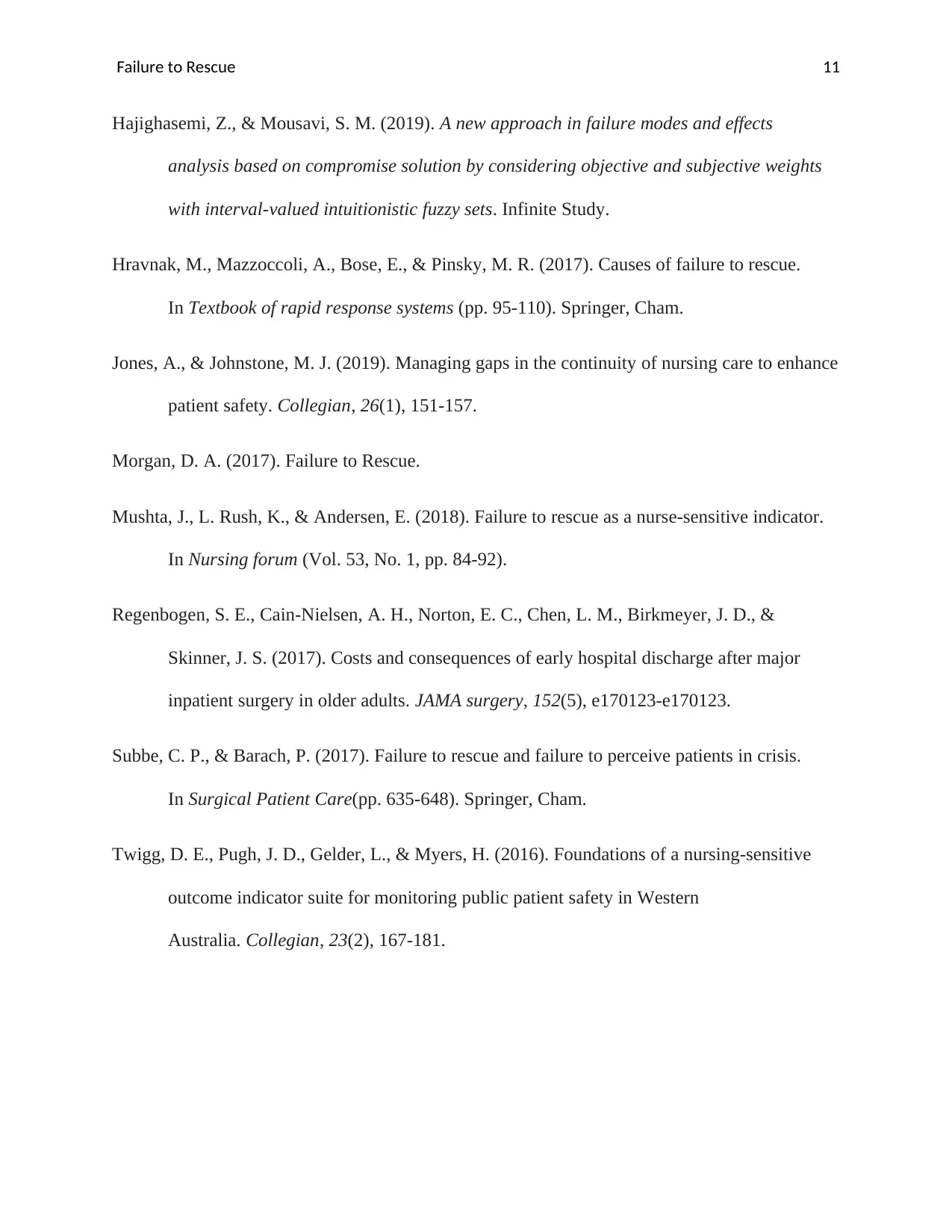
Failure to Rescue 11
Hajighasemi, Z., & Mousavi, S. M. (2019). A new approach in failure modes and effects
analysis based on compromise solution by considering objective and subjective weights
with interval-valued intuitionistic fuzzy sets. Infinite Study.
Hravnak, M., Mazzoccoli, A., Bose, E., & Pinsky, M. R. (2017). Causes of failure to rescue.
In Textbook of rapid response systems (pp. 95-110). Springer, Cham.
Jones, A., & Johnstone, M. J. (2019). Managing gaps in the continuity of nursing care to enhance
patient safety. Collegian, 26(1), 151-157.
Morgan, D. A. (2017). Failure to Rescue.
Mushta, J., L. Rush, K., & Andersen, E. (2018). Failure to rescue as a nurse‐sensitive indicator.
In Nursing forum (Vol. 53, No. 1, pp. 84-92).
Regenbogen, S. E., Cain-Nielsen, A. H., Norton, E. C., Chen, L. M., Birkmeyer, J. D., &
Skinner, J. S. (2017). Costs and consequences of early hospital discharge after major
inpatient surgery in older adults. JAMA surgery, 152(5), e170123-e170123.
Subbe, C. P., & Barach, P. (2017). Failure to rescue and failure to perceive patients in crisis.
In Surgical Patient Care(pp. 635-648). Springer, Cham.
Twigg, D. E., Pugh, J. D., Gelder, L., & Myers, H. (2016). Foundations of a nursing-sensitive
outcome indicator suite for monitoring public patient safety in Western
Australia. Collegian, 23(2), 167-181.
Hajighasemi, Z., & Mousavi, S. M. (2019). A new approach in failure modes and effects
analysis based on compromise solution by considering objective and subjective weights
with interval-valued intuitionistic fuzzy sets. Infinite Study.
Hravnak, M., Mazzoccoli, A., Bose, E., & Pinsky, M. R. (2017). Causes of failure to rescue.
In Textbook of rapid response systems (pp. 95-110). Springer, Cham.
Jones, A., & Johnstone, M. J. (2019). Managing gaps in the continuity of nursing care to enhance
patient safety. Collegian, 26(1), 151-157.
Morgan, D. A. (2017). Failure to Rescue.
Mushta, J., L. Rush, K., & Andersen, E. (2018). Failure to rescue as a nurse‐sensitive indicator.
In Nursing forum (Vol. 53, No. 1, pp. 84-92).
Regenbogen, S. E., Cain-Nielsen, A. H., Norton, E. C., Chen, L. M., Birkmeyer, J. D., &
Skinner, J. S. (2017). Costs and consequences of early hospital discharge after major
inpatient surgery in older adults. JAMA surgery, 152(5), e170123-e170123.
Subbe, C. P., & Barach, P. (2017). Failure to rescue and failure to perceive patients in crisis.
In Surgical Patient Care(pp. 635-648). Springer, Cham.
Twigg, D. E., Pugh, J. D., Gelder, L., & Myers, H. (2016). Foundations of a nursing-sensitive
outcome indicator suite for monitoring public patient safety in Western
Australia. Collegian, 23(2), 167-181.
1 out of 11
Related Documents
Your All-in-One AI-Powered Toolkit for Academic Success.
+13062052269
info@desklib.com
Available 24*7 on WhatsApp / Email
![[object Object]](/_next/static/media/star-bottom.7253800d.svg)
Unlock your academic potential
Copyright © 2020–2025 A2Z Services. All Rights Reserved. Developed and managed by ZUCOL.





